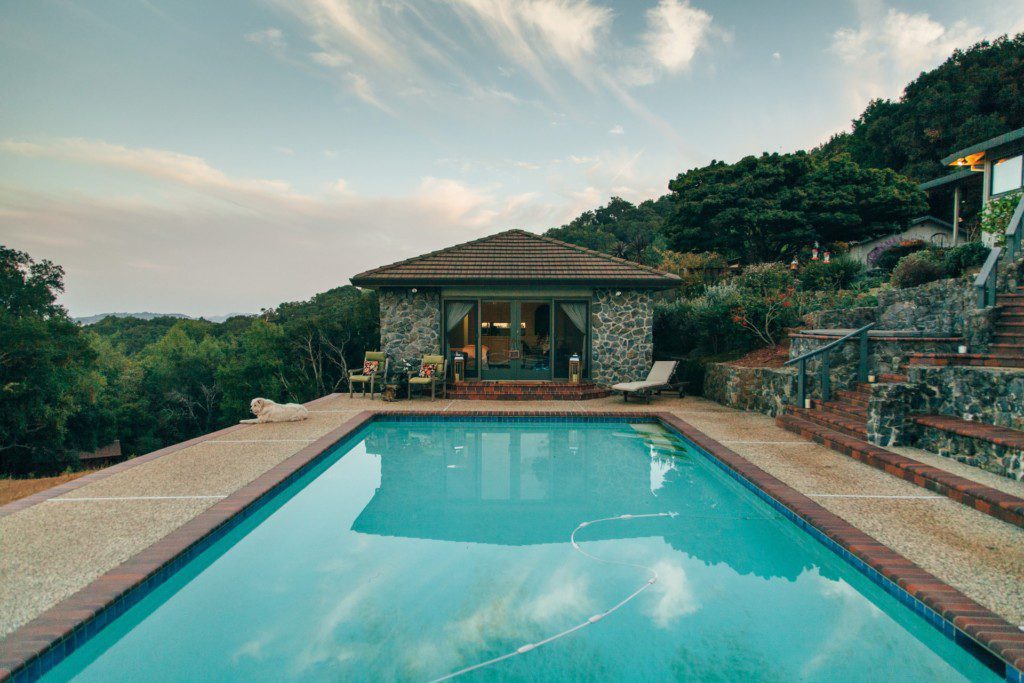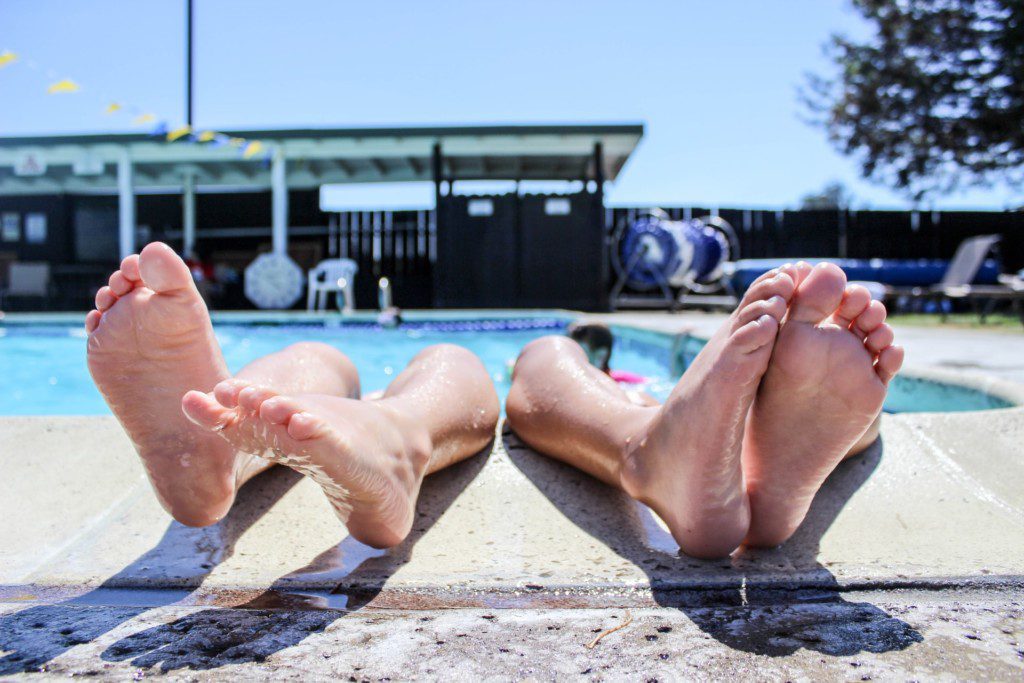12/01/2020 | Swimming Pool & Spa | 8 MINUTE READ
Why You Should Consider a Natural Swimming Pool

Swimming pools are the perfect amenities to have installed in your home. They can provide you and your family with a place to relax while also adding an ample amount of value to your home. While most homeowners opt for standard above-ground or in-ground swimming pools, an increasingly popular type of swimming pool is a natural swimming pool, which is designed to resemble the appearance of ponds, small lakes, and other bodies of water that can be found in the wild. Natural swimming pools are becoming the hot topic in the U.S. because of how friendly they are to the environment. While more traditional pools are able to cause damage to the environment, natural swimming pools are beneficial to the environment.
The main characteristic of a natural swimming pool is that it has an irregular shape instead of the standard oval or circular pools that many homeowners purchase. These pools can also contain boulders, rocks, and waterfalls for a natural setting. Keep in mind that not every pool that comes with waterfalls or rocks is considered to be a natural swimming pool. Another aspect of this pool type that sets it apart is that the water is filtered naturally as opposed to using chemicals for the filtration process.
While natural swimming pools have been very popular across Europe for several decades, they have recently seen a spike in popularity throughout Australia, the United States, and any location with a sunny climate. While you might feel like natural swimming pools would be more difficult to maintain than their traditional counterparts, these swimming pools come with very little maintenance requirements. Since chemical filtration and pH balancing is unnecessary with natural swimming pools, maintenance costs and requirements are kept to a minimum.
Because of these low maintenance costs, natural swimming pools are somewhat cheaper than traditional pools. However, it’s important to understand that the initial investment is higher because of the need to hire a specialized pond and pool builder. If you’re thinking about adding a swimming pool to your property, it’s recommended that you look into the many benefits of natural swimming pools. This article provides a closer look at the numerous reasons why a natural swimming pool may be the perfect fit for your home.
Key Takeaways:
- A natural swimming pool is a pool designed to imitate ponds or other natural bodies of water that is filtered organically rather than by chemicals.
- These swimming pools include a myriad of benefits which include excellent quality of water and more.
- Natural swimming pools add luxury and style to your property, without contributing to damage of the environment.
Why Choose a Natural Swimming Pool Over a Chlorinated One?
 Even though chlorinated pools are refreshing and have their advantages, there are plenty of reasons why you should think about choosing a natural swimming pool over a chlorinated one. When you swim in chlorinated water, the chemicals that are found in this water can leave you with dry skin or itchy and red eyes, which can be frustrating to deal with as you try to enjoy your time in the pool. Since natural swimming pools contain water that doesn’t have any chemicals in it, you won’t have any issues or discomfort after getting out of the pool.
Even though chlorinated pools are refreshing and have their advantages, there are plenty of reasons why you should think about choosing a natural swimming pool over a chlorinated one. When you swim in chlorinated water, the chemicals that are found in this water can leave you with dry skin or itchy and red eyes, which can be frustrating to deal with as you try to enjoy your time in the pool. Since natural swimming pools contain water that doesn’t have any chemicals in it, you won’t have any issues or discomfort after getting out of the pool.
Along with enhancing the aesthetic appearance of your home, natural swimming pools have numerous benefits that can’t be found with chlorinated pools, which include:
- These pools can create a habitat for flora and wildlife
- The maintenance costs for a natural swimming pool are considerably lower than the ones needed for a chlorinated pool
- The quality of water is excellent
- Water treatment and filtration can occur without the use of chemicals
- These pools are highly adaptable and can be used in practically any climate
A natural swimming pool is part of an ecosystem that supports insects, amphibians, plants, and other forms of aquatic life. While you will be swimming among an ample amount of aquatic life, this life keeps the water within the pool clear and clean. The aquatic life that can typically be found in a natural swimming pool includes amphibians, insects, and snails. There are also microscopic creatures called daphnia that consume bacteria and keep water clean.
As for plants, the many plants that can be found in a natural swimming pool have several functions that are necessary for the maintenance of this type of swimming pool. For instance, floating plants like water lilies are responsible for providing shade from ultraviolet rays for the microorganisms that live within the water. The root structures of many plants are able to act as natural water filters that can get rid of excess nutrients and contaminants.
How Does a Natural Swimming Pool Work?
 The purpose of a natural swimming pool is to accurately mimic the natural environment, which is why these swimming pools consist of two separate areas. Along with the area of the pool that’s used for swimming, another area will exist for the purification of water. Keep in mind that the overall design of the pool can vary significantly depending on the size of your yard and the type of investment you want to make when creating the pool. Most natural swimming pools are around 100-160 square feet in size. However, it’s possible to have an even smaller natural swimming pool if necessary.
The purpose of a natural swimming pool is to accurately mimic the natural environment, which is why these swimming pools consist of two separate areas. Along with the area of the pool that’s used for swimming, another area will exist for the purification of water. Keep in mind that the overall design of the pool can vary significantly depending on the size of your yard and the type of investment you want to make when creating the pool. Most natural swimming pools are around 100-160 square feet in size. However, it’s possible to have an even smaller natural swimming pool if necessary.
While the exact percentages depend on how the natural swimming pool is designed, the swimming zone for the pool will be comprised of around 50-75 percent of the total water. The remaining water will be used for filtration purposes within the filtration zone. Water will be pumped directly to the shallow filtration zone, after which the ample plant life in the area will effectively filter the water. However, it’s very important that the plant life in the filtration zone is properly maintained. In order for the plants to survive and thrive, the pH levels within the water should remain at 5.5-7.0 pH. Keep in mind that pH levels are easy to test for as long as you have the right water sensor for the job. For instance, the S8300 pH sensor can provide you with fast and precise results.
When designing the pool, there are several additional factors that should be taken into account. For instance, the surface area of the pool should be relatively large if you want to effectively avoid the development of algae. For a healthy pool, the surface area should be at least 150 square feet in size. As for the depth of the pool, deeper pools tend to result in cooler water. The ideal depth is around 3-7 feet. Try to create your natural swimming pool in an area that doesn’t get a substantial amount of sun. The sun directly promotes the growth of algae. Floating plants and leaves can mitigate this issue and slow the growth of algae.
Heating a Natural Swimming Pool
 There are three separate methods that you can use to heat a natural swimming pool, which include sunshine, coverings, and heat pumps. Relatively shallow pools are able to hold heat well, which means that sunshine may be enough to heat your swimming pool. Underground heat collection pipes could be placed under the pool to facilitate warmer water. If you decide to opt for the covering method, this is considered to be the more cost-effective method for heating pool water. Solar panel covers will float on the water and increase temperatures when it’s sunny outside.
There are three separate methods that you can use to heat a natural swimming pool, which include sunshine, coverings, and heat pumps. Relatively shallow pools are able to hold heat well, which means that sunshine may be enough to heat your swimming pool. Underground heat collection pipes could be placed under the pool to facilitate warmer water. If you decide to opt for the covering method, this is considered to be the more cost-effective method for heating pool water. Solar panel covers will float on the water and increase temperatures when it’s sunny outside.
While it’s possible to obtain inexpensive pool covers for around $2,500, the most effective solar covers will cost you anywhere from $10,000-$15,000. When looking specifically at heat pumps, these pumps can efficiently heat water when connected to solar panels. However, the swimming pool should still be covered. The heater itself can cost anywhere from $5,000-$15,000. The insulation cover costs are around the same, which means that your total costs for the heat-pump method can be anywhere from $10,000-$30,000. The method that you select largely depends on the kind of budget that you’re working with. While heat pumps are highly efficient, the initial investment will be on the higher end.
Final Thoughts
Natural swimming pools are beneficial in a variety of distinct ways. If you want to improve the appearance and value of your home, these swimming pools can add style and luxury to any property. Natural swimming pools are also fantastic for the environment. When maintaining a traditional swimming pool, chemicals would need to be added to the water in order to keep pH levels balanced and to make sure that the water was properly filtrated. Natural swimming pools can be filtered without the need for chemicals, which means that you’ll be able to swim in natural water that won’t aggravate the skin.
By eliminating the use of chemicals in your swimming pool, you won’t be contributing to the damage of the environment with your pool. The lack of chemicals also means that the maintenance requirements for a natural swimming pool are less stringent. Unlike traditional pools, natural pools work well in all climates. It’s also important to note that natural pools are adaptable and can be made in a variety of different designs. While the upfront costs can be high, the maintenance savings and boost in home value should offset these costs. Once you find the right pool builder for the job, you should be able to create a pool that matches your specifications and adds significantly to the aesthetic appeal of your home.
Posted by Sensorex on December 1, 2020
Sensorex is a global leader in the design and manufacture of quality sensors for water quality and process applications. The company offers more than 2000 sensor packages for pH, ORP, conductivity, dissolved oxygen, free chlorine, chlorine dioxide, UV transmittance and other specialty measurements, as well as a full line of sensor accessories and transmitters. Its expert technical support engineers solve analytical sensor challenges with custom designs and off the shelf products.




